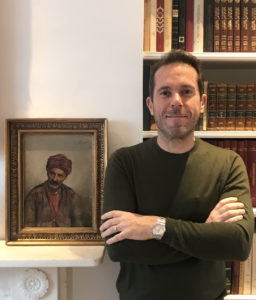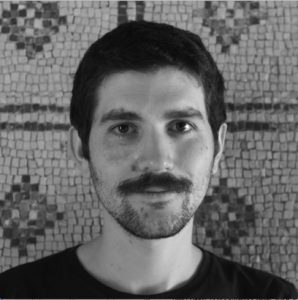Davidian Receives SAS Outstanding Dissertation Award

Vazken Davidian
The Society for Armenian Studies (SAS) announces that Dr. Vazken Khatchig Davidian has been chosen to receive the SAS Distinguished Dissertation Award (2017-2020) for his dissertation “The Figure of the Bantoukhd Hamal of Constantinople: Late Nineteenth-Century Representations of Migrant Workers from Ottoman Armenia.” The SAS Award is accompanied by a $1,000 prize. Dr. Hrag Papazian’s “Contesting Armenianness: Plurality, Segregation and Multilateral Boundary Making among Armenians in Contemporary Turkey,” received an honorary mention.
Davidian’s thesis examines late nineteenth century visual representations of the subaltern figure of the bantoukhd (migrant worker) from Ottoman Armenia, synonymous – in both Russian Armenian and Ottoman Armenian contemporary popular imaginations – with the iconic hamal (porter) of Constantinople. The period under scrutiny spans the two decades loosely bookended by the immediate aftermath of the Russo-Ottoman War of 1877-1878 and the Armenian Massacres of 1894-1897, a significant historical period that experienced, among others: the internationalization of the so-called Armenian Question; the fraying of the relationship between the Ottoman State and its Armenian population; the unprecedented increase in labor migration from Ottoman Armenia to Constantinople; the advent of a social-reformist intellectual movement, the so-called Constantinople Realists; and the spearheading of notions towards the ‘salvation’ of Ottoman Armenia as a cause by Russian Armenian intellectuals.
Dr. Davidian commented on the award saying, “I am deeply honored and sincerely moved by the recognition conferred upon my dissertation by the Society of Armenian Studies and the Selection Committee. The dissertation was a labor of love by a mature student, arriving to academic pursuits later in life, and was driven by a desire to engage with the contexts and complexities of the Ottoman Armenian past, and especially some of its more neglected aspects. Using art and social history as a prism, my work has sought to identify artists as central figures of a late nineteenth-century Ottoman Armenian intellectual milieu and actors in the movement for social and political reform. I am grateful to be part of a new generation of scholars who are constantly building upon and pushing the boundaries of the pioneering work of those who established Armenian Studies.”
Davidian is Calouste Gulbenkian Post-Doctoral Fellow at the Oriental Institute, University of Oxford. He defended his doctoral thesis in art history at Birkbeck College, University of London in 2019. He is, along with Boris Adjemian, co-Editor of the journal Études arméniennes contemporaines published by the Bibliothèque Nubar (ABGU Nubar Library), Paris. He edited the volumes Towards Inclusive Art Histories: Ottoman Armenian Voices Speak Back (EAC 6, 2015) and, with Susan Paul Pattie and Gagik Stepan-Sarkissian, Treasured Objects: Armenian Life in the Ottoman Empire 100 Years Ago (Armenian Institute, 2012). His published articles include ‘Portrait of an Ottoman Armenian Artist of Constantinople: Rereading Teotig’s Biography of Simon Hagopian’ (EAC 4, 2014) and ‘Image of an Atrocity: Ivan (Hovhanness) Aivazovsky’s Massacre of the Armenians in Trebizond 1895’ (EAC 11, 2018). He is currently working on a monograph based in part on his doctoral dissertation.

Hrag Papazian
Papazian’s dissertation deals with the ways in which Armenianness in Turkey in the past three decades witnessed an unprecedented process of diversification. Whereas members of the Christian-Armenian minority had traditionally been the sole representatives of Armenian identity in Turkey, they now find themselves next to two other groups of Armenians: first, officially Muslim and hence ‘non-Armenian’ citizens of Turkey who, drawing on their Armenian ancestors Islamized or Alevised decades or centuries earlier, have started to publicly identify as Armenians; second, citizens of neighboring Armenia who engaged in a labor migration towards Turkey after the independence of their country and its sinking into a political, economic, and energy crisis in the early 1990s. Going beyond the official categorization of Armenians in Turkey, limited in scope and imposing a particular interpretation of Armenianness, his ethnographic research studies the various people self-identifying as Armenians in today’s Turkey. It examines the often-differing meanings, productions and experiences of Armenianness among the Christian Armenians, the Muslim/Alevi Armenians, and the migrant Armenians. The study aims at understanding and explaining the boundary-making processes between these three Armenian factions. In that endeavor, it argues that the making of symbolic and social boundaries between them are conditioned both by irreconcilable differences between each one’s understanding and expectations of Armenianness, and by practical factors related to interest and security. Finally, broadening its scope of analysis, the dissertation argues that the making of intra-Armenian boundaries is also influenced or conditioned by the Armenian factions’ relations and boundaries with third parties, namely the Turkish state and Muslim majority, thus advancing a theory of multilateral social boundary-making.
Upon receiving the title of honorary mention, Papazian said, “Please accept my deepest gratitude for selecting my doctoral dissertation for this honorary mention. I am delighted that “Contesting Armenianness: Plurality, Segregation and Multilateral Boundary Making among Armenians in Contemporary Turkey” is appreciated by scholars in our growing and diversifying field of Armenian Studies.”
Papazian is Promise Armenian Institute postdoctoral scholar in the Department of Anthropology at UCLA. He earned his doctoral degree in anthropology from the University of Oxford (2020) where his dissertation about Armenians in contemporary Turkey was awarded the David Parkin Prize. Papazian’s research interests include religion and race, ethnicity and nationalism, migration and diasporas, politics and activism, and the (un)making of social boundaries. He has conducted ethnographic fieldwork in Turkey and Armenia and has previously taught at the American University of Armenia for two years. As a visiting scholar at Cambridge, Papazian examines the popular perceptions and the political instrumentalization of Turkey and the “Turk” in Armenia after the 2020 Nagorno-Karabakh war.
“This year we have received the largest pool of dissertations in the history of the Society for Armenian Studies (SAS),” said Bedross Der Matossian, President of the SAS. “All of them were excellent dissertations from a variety of fields: history, political science, sociology, linguistics, and anthropology. This is a testimony to the advancement of the field of Armenian Studies from interdisciplinary perspectives. For the past seven months a committee of four closely examined the dissertations and ranked them. I would like to thank the members of the committee for their hard work.”
The Society for Armenian Studies, founded in 1974, is an international professional association representing scholars and teachers in the field of Armenian Studies. The aim of the SAS is to promote the study of Armenian culture and society, including history, language, literature, and social, political, and economic questions.
The SAS (societyforarmenianstudies.com) is headquartered at the Armenian Studies Program at California State University, Fresno. It publishes the peer-reviewed Journal of the Society for Armenian Studies and a semi-annual online Newsletter, and organizes panels and conferences on Armenian Studies.
For more information please contact Prof. Bedross Der Matossian at bdermatossian2@unl.edu.







